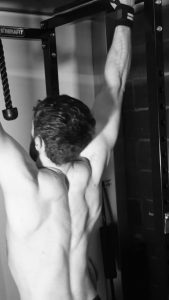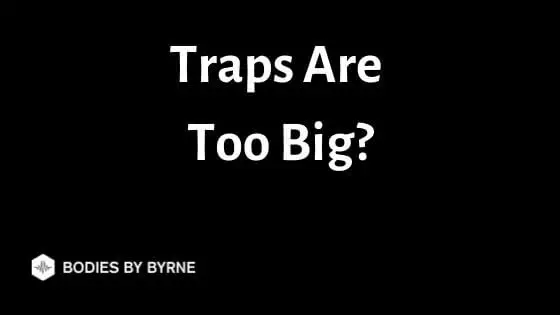I tend to cover a lot of topics in relation to hardgainers, bulking up, building muscle and generally improving your overall physique and body composition.
It’s rare to come across complaints of a muscle group being too big!
In fact it’s usually the complete opposite with people struggling because their muscle groups are too small, especially in comparison to other body parts.
There is however one quite common exception to this and that is for people who have overactive traps and they therefore grow at a much quicker rate than other muscle groups.
Why your traps are too big:
Not many people complain about muscle groups being too big however there are those that have overactive traps during training which means they have grown too big in proportion to other muscle groups.
The key to lessening the activation of the traps is to keep your shoulder blades down during a lift.
Traps Are Too Big!!
When you use the term too big in terms of a person’s physique then that generally doesn’t carry much meaning behind it. The world’s top bodybuilders compete at a body weight in excess of 250lbs and they are always looking to get bigger!
Now most people don’t have the aspirations or desire to look like a top level body builder and for the general public there does come a point when a muscle is considered to be too big.
When someone says that their traps are too big, what this usually means is that the traps are too big in relation to other muscle groups and therefore creates a very unbalanced physique and just looks quite odd.
That muscle groups that will make this most noticeable are small shoulders on their own or this can be more exaggerated by a small clavicle (collar bone), this would certainly cause a lack of balance to you aesthetics and is usually the top issue.
The other muscle groups to look out for are the rhomboids and upper back muscles and also your lat muscles.
If these are not well developed and have adequate thickness and width to your upper body then your traps will stand out a mile away for all the wrong reasons.
Your priority should of course be to bring up your upper body to a level that matches your traps but that is a lot easier said than done because you can’t get traps out of proportion just by doing a few extra sets of shrugs.
Why Are Your Traps Too Big

The main reason why many feel their traps are too big is because they have the issue that they are an overactive muscle group for them.
An overactive muscle is one that you can recruit muscle fibres for very easily and therefore can be stimulated even when they are not being directly trained.
This can either be due to genetics (a naturally larger muscle group will tend to be recruited easier as your body feels it can more safely handle a load) or more commonly due to back movement mechanics which have been learned and ingrained through bad form.
A good example of this is someone that bench presses a lot, has big triceps, big front delts however a comparatively small chest.
The triceps and front delt in this example are what the body feels are most suited to handling the movement and therefore recruit them first which means they grow more as a result.
This can be a pretty vicious cycle for those exercising for performance or aesthetics, good form is not only recommended to prevent injury but also to ensure that you are recruiting the muscle that you actually want to work.
Overactive traps are common in a lot of heavy and you can easily recruit them in exercises that you wouldn’t be aware of.
Deadlifts are a whole posterior chain exercise so you can expect to recruit them during this but did you know you can recruit the upper traps during a row, overhead press and even side lateral raises that are intended to target the shoulders?
The reason for this is because if you don’t have full control over the weight with the working muscles then more often than not you will perform a small shrugging type motion in order to get the momentum to complete the rep.
Rows that are too heavy for the individual and heavy side lateral raises are by far the most common culprits here.
If you have traps that are too big then I’d put money on it that you perform side lateral raises with dumbbells that are just too heavy.
How to You Fix Overactive Traps
To fix overactive traps you are going to have to analyze all of your upper body movements and make sure that you are both initiating the exercise with the intended muscle group and finishing it with no momentum or shrugging.
For most this means that you will need to seriously get your ego in check, drop the weight a little and make sure you are working the intended muscle only.
Taking a conscious effort to analyze your sets will really show flaws in your technique and highlight the main reasons why your traps are being active during the movement.
Even on a lat pulldown when you are moving in the opposite direction to a shrug people will hit a sticking point and still shrug their shoulders upwards in an effort to move the weight.
You will genuinely be surprised by how easy it is to rely on your traps to help a movement out.
A lot of people all do this with other back muscles however that back is such a large muscle group that it doesn’t get stimulated and grow the same way that the traps do, particularly the upper traps.
The next way to fix overactive traps is to keep your shoulder blades down and tucked with your chest held high.
Focusing on squeezing your shoulder blades together and keeping them down will keep your upper traps out of the movement.
By doing this you will still recruit the lower traps but these are often a lot less developed in comparison to the upper traps anyway so don’t worry about this.
The reason traps are overactive is because of any form of shrugging motion, once your shoulders rise up past parallel then your traps are involved so try to keep those shoulder blades tucked as often as possible.
Another technique that you can use is to wrap a band around your traps in order to keep them pressed down with tension during any overhead pressing movements or lateral and rear raises that target the shoulders.
The shoulders are usually the exercises when the traps will come into play the most, drop your weights on these and focus on squeezing through the delts.
With the band holding your traps down and in place you’ll be consciously forced to keep them down under the tension.
Finally just remove and replace any exercises that unnecessarily bring the traps into activation. Swap standing lateral shoulder raises for lying lateral raise and swap incline rear delt raises for bent over cable face pulls.
Related – Why lateral raises work traps
Any exercise that brings the traps into activation will cause you an issue until you reprogram your body to activate the desired muscle group during an exercise.
This can take a while to develop the neuromuscular connections all over again so be patient and stick with it.
How to Reduce the Size of Your Traps
Once you have developed your traps to a point that they are considered too big you are only really left with two options.
The first is to stop training them and let the muscle atrophy and lose size though this would not be my recommendation.
If you perform any heavy compound movements like deadlifts of front squats then the traps will be active regardless as a secondary muscle so you will still get some stimulation even if you stop all direct trap work.
The second option would be to bring up the rest of your muscle groups to balance out the muscular imbalances.
This is one that is easier said than done however you must have sufficient hypertrophy potential if your traps are big enough to be reading this article.
Therefore I’d look into specialized shoulder programs to really help even out your upper body. I’ve produced a shoulder plan for GoNutrition’s site however there are hundreds that are more in depth and specialized available online.
How to Work Shoulders Without Working Traps
I touched on this earlier however the key issue with overactive traps is usually brought about by poor form and exercise selection when it comes to working your shoulders.
Therefore to work your shoulders without working traps you should lower the weight for pretty much all your exercises and learn form that starts with no movement of the traps.
I mentioned a lying down lateral raise as a good alternative to a standing lateral raise however a leaning lateral raise works just as well to move all tension from the trap area and straight onto the shoulders.
When doing any form of raise you also want to be visualizing moving the weight away from your body in an arcing motion that leads with the hands and elbows.
You need to visualize pushing the weight away from you rather than focusing on an upwards direction.
This simple tweak to you approach to the exercise will almost completely remove the trap activation from the movement and also fully engage the delts, this sort of visualization is better known as an exercises queue.
Exercise queues help maintain proper form and create a mental trigger for engaging a muscle group.
You will also want to remove any shoulder movement that creates any form of shrugging motion such as an upright row or front raise that finishes above your eye line.
These exercises are not crucial for shoulder development and therefore it’s easier to just remove them completely.
Your key queues to remember lastly when working shoulders whilst trying not to work your traps should be to keep your shoulder blades down and tucked and to avoid any movement with a shrugging motion.
The shoulder blades down are a key one, even when overhead pressing there is a tendency to press too high and bring your traps into play to finish the movement.
Ego will play a big part in this but if you want a more balanced physique then this is unfortunately the route you will need to take in the short term.
Also if you want to reverse engineer this process then you can check out my article on actually growing your traps (if for no other reason than to avoid this training method!):
How to grow bigger traps
What Next
If you are looking to make changes to your physique by either losing body fat, building muscle or looking to maintain a lean physique then sign up to my weekly newsletter below. Each week I send out actionable tips to help you lose that extra 1lb of fat or build that extra 0.5lb of muscle mass on a weekly basis.
If you sign up now you’ll also receive my 28 day body recomp program completely Free. This ebook will be sent straight to your inbox and will provide an intense 28 day program aimed at helping you lose up to 8lbs of body fat whilst also building 2lb-4lb of lean muscle mass in just 4 weeks.
Don’t worry if you’re not ready for an intense program just yet, my weekly newsletter will give smaller tips that when implemented daily, will stack up over time and see you transform your body with seemingly minimal effort!
